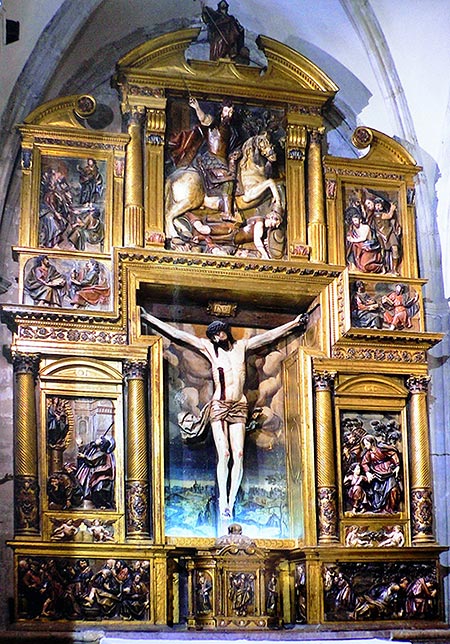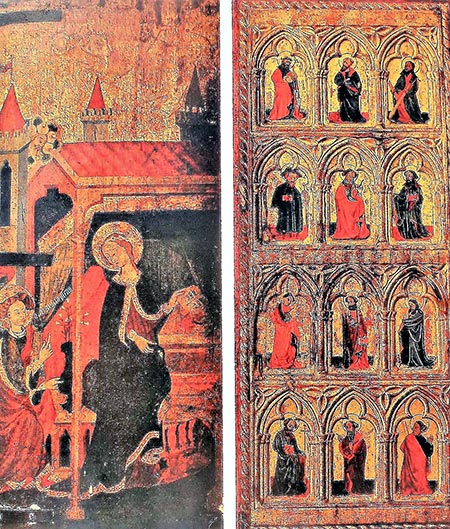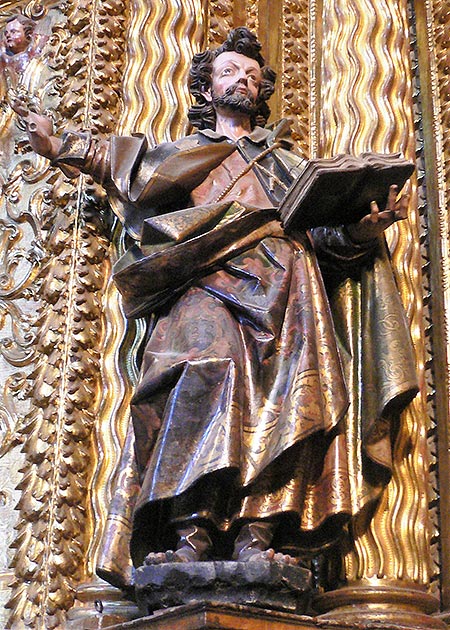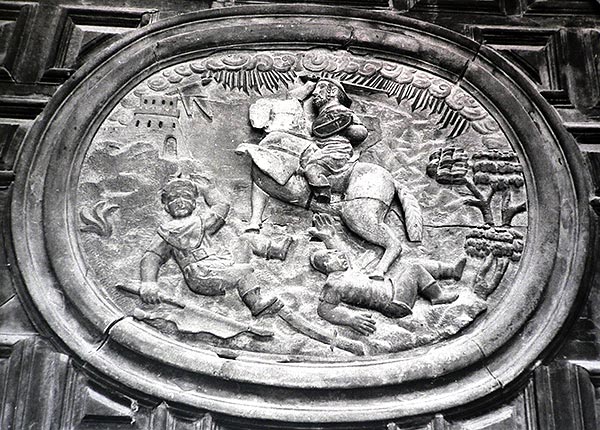October 18
Jacobean iconographic heritage in Estella and surroundings
Carmen Jusué Simonena
Historian
...in these moments we need to reencounter everything that accompanies and generates the Camino a Santiago: its deep and spiritual sense, the recovery of social relationships, the exchange of experiences, and an attitude and behavior always constructive and respectful with nature.
With these words and a wise wish, the King of Spain, Felipe de Borbón, proceeded on July 12, 2021 to the official opening of the Compostela Holy Year in Roncesvalles, accompanied by all the presidents of the Autonomous Communities through which the Pilgrims' Route to Santiago de Compostela passes.
The celebration of the new Jacobean Year is on this occasion double, and arouses interest, even more if possible, on various aspects related to the figure of St. James, given that the history of pilgrimages to the tomb of the Apostle have been shaping, over the centuries, a very rich bequest on all routes to him.
In this context, the Way of St. James came to represent, from the confines of Italy, Germania or Scandinavia to the Galician Finisterre, the most spectacular sign of physical and spiritual concurrence of individuals and crowds. A path of devotion, but also a channel of goods, feelings, knowledge, convictions and dreams, the Jacobean pilgrimage route was undoubtedly the European road par excellence.
Jacobean research or works have been largely oriented to everything related to the Camino de Santiago in any of its routes, to the various towns or regions through which it runs, to the artistic manifestations, hospitality, worship, legends, brotherhoods, articulation of space, and to so many ways of worship related to Santiago. In this sense, the iconography of the Saint does not really suppose a novelty, since it has been treated in multiple programs of study with great detail and success, nevertheless, the complete analysis of the advocations and iconographic manifestations of the Apostle in a region are really scarce, or at least little known. For that reason, today I want to gather all those expressions of worship and the different iconographic aspects that it presents in Estella and its surroundings, in the Lands of Estella.

Viana. Church of Santa Maria. Altarpiece of Santiago. XVII century.
Four are the itineraries that lead to Santiago and that, in Puente la Reina, in Spanish lands, converge in only one. With this singular and clear summary of geography begins the guide of pilgrims of Aimerico Picaud, author of the Liber peregrinationis or guide of the pilgrimage that composes the fifth book of the Liber Sancti Jacobi, better known as Codex Calixtinus, manuscript realized in the XII century, and in so brief text the nuclear function of Navarre as crossroads of the jacobean ways of Europe is already intuited, because Navarre is not just a place to pass through, not even a stop on the Way, given that its condition as the western gateway to the Peninsula and, consequently, the plane of meeting of the great Jacobean arteries, stirred up the calm waters of its primitive social structure to the very depths.
Through the Pyrenean passes of Somport and Ibañeta and with the pilgrims and their retinue of adventurous merchants, fundamental elements of Western European civilization circulated intensely. The Song of Roland spread the name of Roncesvalles to all corners of Europe, and its most moving verses must have resonated strongly in the hearts of pilgrims, knights, clerics and travelers who entered Navarre, a land of legend, enchantment and mystery.
St. James in the Spirit. Worship and devotion to the Apostle
"The path of stars that you saw in the sky means that from these lands to Galicia you will go with a great army.... And after you all the peoples will go there on pilgrimage, from sea to sea, asking forgiveness for their sins.... And truly they will go from your times until the end of the present age" (Words of the apostle James to Charlemagne, according to the History of Turpin, of the 13th century).

Estella. Church of the Holy Sepulchre. Detail of the frieze of the Apostleship.
In the central figure, stone image of Santiago Apostle and Pilgrim. XIV century.
According to a beautiful story, at an imprecise date in the ninth century, possibly around 830, during the reign of Alfonso II of Asturias, a hermit, named Pelayo, observed certain luminous phenomena similar to a shower of stars near the place where he lived. Theodomiro, bishop of Iria Flavia, was warned and went with his faithful to the place indicated, where they found a cave containing a marble ark. The remains inside were identified with those of Santiago el Mayor. It is an episode in which the real data -finding of the sepulcher-, appear interwoven with other popular traditions, but that in final explain the origins of Compostela. Indeed, when the finding took place, the bishop of Iria Flavia was far from imagining the consequences that this finding would have over the centuries, making it one of the most important places of pilgrimage in Christianity. The cult of St. James created the Camino. The flow of pilgrims, traders or adventurers, continually renewed, especially numerous in the Holy Years, has made the history of this Way.
Religious establishments. Temples, chapels, chapels, hermitages, altarpieces.
Given that the diplomas of Alfonso III record the arrival of pilgrims to Compostela at the end of the 9th century, it is logical that from then on the increase in the number of people heading for the tomb would lead to a rapid expansion of the cult of the Apostle. It will be, therefore, in the middle of the X century X especially in the eleventh century when the transit of pilgrims begins to be captured as a common phenomenon, and that is the time from which the main devotional samples to the Apostle can be traced. Therefore, we should ask ourselves what manifestations are considered as samples of this cult, so it has been considered to value, at first, the dedication of the temples that had their origin in the cult of the martyrs.

Estella. Basilica of Our Lady of Le Puy. Door of the ark that, according to tradition, housed the Virgin of Puy.
XIVth century.
In this sense, it can be said that the dedications to St. James in parish buildings or churches are quite numerous and many of them have their roots in the Middle Ages average. The new buildings of the modern centuries were also important, and the 20th century was the time when the last parish church of Santiago was erected in these lands, specifically in Pamplona. In the lands of Estella, the parish dedications to Santiago de Abárzuza stand out, specifically in Andéraz, Cabredo, Olejua and in the uninhabited village of Novar in Riezu, in the valley of Yerri.
Also the hermitages have their importance in the cult of Santiago, because they obey a complementary religiousness subject in their surrounding environment. Those dedicated to the Apostle are relatively frequent. There are 24 hermitages dedicated to St. James in Navarre, although most of them have disappeared, leaving only some quite late documentary news. Preferably located in the pre-Pyrenean basins, middle areas of Navarre and the Baztan route, some of them have their roots in medieval times, such as that of San Felipe and Santiago de Estella, which at first may have been dedicated to Santiago el Menor, or that of Santiago de Lóquiz, in the municipality of Ganuza.

Marañón. Parish of Our Lady of the Assumption. High Altarpiece. Bench.
Table with five apostles, presided by Santiago, Hispano-Flemish style. XVI century.
There are also numerous altarpieces dedicated to St. James, generally located in churches consecrated to the Apostle and in those places where there was a Santiaguista confraternity. Built mainly between the XVI and XX centuries, these new altarpieces were built to adequately decorate the temples, to render worship and to increase and promote devotion, that is to say, in many cases they responded to an idea of ostentation that wanted to give their rites the greatest possible solemnity and brightness. A good part of them are major altarpieces located in churches under his invocation, as is the case of Cabredo, Olejua; others are located in localities where there was or is a Brotherhood of Santiago, which is logical, since the brotherhoods frequently had altars under the invocation of the venerated saint, as is the case of Estella, Viana or others like Cárcar, Lorca, Sesma or Zúñiga.
Iconography of Santiago
One of the interesting aspects that can be treated around the figure of St. James is that of his iconography, given that the way of representing the image of the Apostle through time, or different artistic styles, is especially attractive and even instructive by the fact that sample states of opinion and predilections marked through circumstances and times.

The Arches. Church of Santa Maria. Santiago Apostle and pilgrim in the High Altarpiece. XVII century.
From the iconographic point of view there are three types of fundamental representations that qualify Santiago: apostle, pilgrim and knight. Logically, the first of these is due to the choice that Christ made of him to send him, like the other apostles, to preach the Gospel, and like all the direct disciples of Christ he is represented in the various series of apostolates. The figure of pilgrim was obtained with time, considering that he is considered the first pilgrim to Compostela, initially in his preaching and later after his martyrdom by order of Herod Agrippa I, between the years 41 and 44.
The representation of the apostle St. James as a knight occupies an important place in his iconography, a relevance that is accentuated by the fact that it is a Hispanic variant that will later be transferred to American lands. Frequently the figure of St. James the knight has been immersed in the heterogeneous world of the "victorious horsemen" that multiply throughout the medieval churches of France and Spain.

Cabredo. Church of Santiago. Wooden relief on the door of the church representing Santiago Caballero.
XVII century.
However, these are not the only representations of the Apostle, since history and tradition have given rise to others inspired by his preaching, martyrdom and his transfer to Compostela, thus creating a cycle based on the Gospels, the Acts of the Apostles or the admirable events and miracles narrated by Jacobo de la Vorágine or in the Liber Sancti Jacobi, Codex Calixtinus.
Thus, under the protection of the Apostle's report , the luminaries that illuminated the finding of his tomb never ceased to shine throughout the length and breadth of nascent Europe, and no less Degree the countless pilgrims of yesterday and today are the best witnesses of the Camino, since it should not be forgotten that their main motivations are to see, contemplate, walk and pray.
Because the Camino, like beauty, knows no borders.
